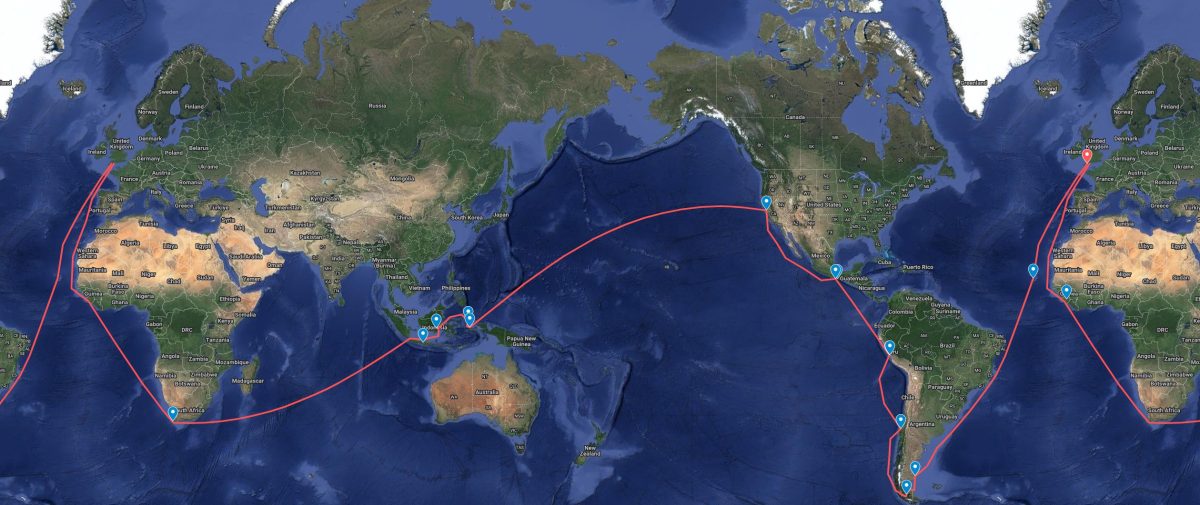Follow the route of Francis Drake – Circumnavigation of the Globe (1577-1580)
Dates
- Between 1577 and 1580 – circumnavigation of the globe
- Departed from Plymouth on 13th December 1577
- Returned Plymouth on 26th September 1580
Places visited – Circumnavigation of the Globe (1577-1580)
South America
Strait of Magellan
Valparaíso, Chile: He raided Spanish settlements along the Chilean coast.
Lima, Peru: He captured the Spanish treasure ship Nuestra Señora de la Concepción near Lima.
Guatulco, Mexico: He continued raiding Spanish settlements along the coast.
Pacific Islands
Ternate, Moluccas (Indonesia): Drake visited these spice islands in 1579 and secured a trade agreement with the Sultan of Ternate.
Java: He stopped in Java before continuing his voyage.
East Indies: Drake explored parts of the East Indies and engaged in trade and navigation.
Atlantic Ocean
Cape Verde: During his circumnavigation, Drake captured Portuguese ships off the coast of Cape Verde.
West Africa: He engaged in the slave trade along the West African coast early in his career.
Europe
England: Drake returned to England in 1580, completing his circumnavigation. He was knighted by Queen Elizabeth I in 1581.
Discoveries
New Albion (California)
Location: Present-day California.
Discovery: During his circumnavigation in 1579, Drake landed on the west coast of North America. He claimed the area for England, naming it “New Albion.”
Significance: This claim was one of the earliest English territorial claims in the New World, though it was not followed up by immediate colonization.
Drake Passage
Location: The body of water between the southern tip of South America and Antarctica.
Discovery: While Drake did not discover the Drake Passage himself, his voyage around the southern tip of South America through the Strait of Magellan highlighted the existence of a possible open sea route south of Tierra del Fuego. The Drake Passage was later named in his honour.
Pacific Ocean
Significance: Drake was the first Englishman to navigate the Pacific Ocean. His successful passage from the Atlantic to the Pacific via the Strait of Magellan and his subsequent exploration of the Pacific coast of the Americas expanded English knowledge of these waters.
Spice Islands (Moluccas)
Location: Present-day Indonesia.
Significance: Drake visited the Spice Islands in 1579 and established trade relations with the Sultan of Ternate. This opened up new opportunities for English trade in the lucrative spice market.
Exploration of the East Indies
Significance: Drake’s exploration of the East Indies and Java contributed to European knowledge of the geography and trade routes in this region.
Adventures
Sight of the Pacific Ocean
- Adventure: After crossing the Isthmus of Panama, Drake became the first Englishman to see the Pacific Ocean in 1573.
- Significance: This moment was significant as it fuelled his ambition to explore and navigate the Pacific, eventually leading to his circumnavigation of the globe.
Capture of the Cacafuego (Nuestra Señora de la Concepción)
- Adventure: In 1579, off the coast of Peru, Drake captured the Spanish galleon Cacafuego, which was laden with treasure.
- Significance: This was one of his most famous exploits, yielding a massive haul of gold, silver, and precious stones, and significantly boosting his wealth and reputation.
Notable Incidents
- Surviving Mutinies and Shipwrecks: Throughout his voyages, Drake faced and overcame numerous challenges, including mutinies, shipwrecks, and fierce battles with Spanish forces.
- Ingenious Tactics: Drake was known for his cunning tactics, such as using false flags to deceive enemy ships and his strategic use of fire ships during the battle against the Spanish Armada.


